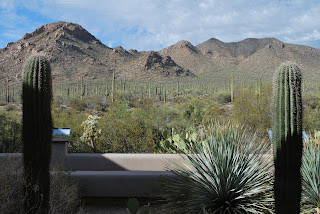

13. Saguaro National (West)


Heat hung in the valley, we made the visitor's center and grabbed a map of the park.

Hagel and I did a 5 or 6 mile hike up to a peak in the evening then walked down among the monstrous cacti columns in the coming dark.


This shaking rattler s'd up at the foot of the trail. I assumed it a western diamondback, but the mojave rattlesnake apparently looks quite similar. The white stripes near the shaker stretch wider than the black stripes on the mojave.

From the U.S. forest service pamphlet and a park newspaper, I gathered info-tidbits on the saguaro catus (Carnegia gigantea). A saguaro takes about 150 years to reach the highest heights (up to fifty feet tall), it takes around 100yrs to make 50feet. The roots grow shallow but can extend out as long as the plant is tall. One plant can slurp up 200 gallons of water in a single rainfall. The wavy ribs of the cactus swell to handle excess water and the waxy skin exterior restricts water loss. The cactus tissue is around 85% water, a large plant can weigh 16,000 pounds or more.



100 flowers bloom on each plant over a four week period. The flowers bloom white and yellow in the night. They close the following day around noon. Bats and birds pollinate the plants amid this gap of time. The saguaro produces 40million seeds in a lifetime, one of which will likely reach maturity. Gila woodpeckers peck out holes & gilded flickers, cactus wrens, elf owls, mice, snakes, and spiders settle in.



We made a tensite park after dark at the Gilbert Ray Camp. The full mooned brightened, the coyotes yipped, and we did some video of ants climbing in and out of their massive mound in the Sonoran desert earth.


Rolling northwest toward Phoenix the struggling saguaros stood with the help of crutches along highway 10.


